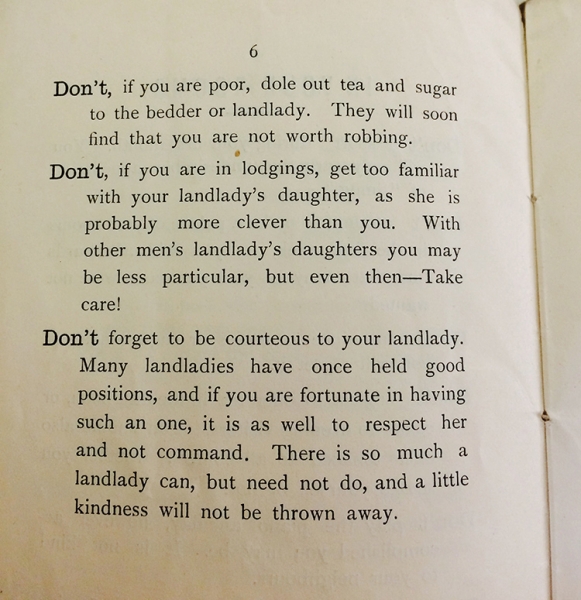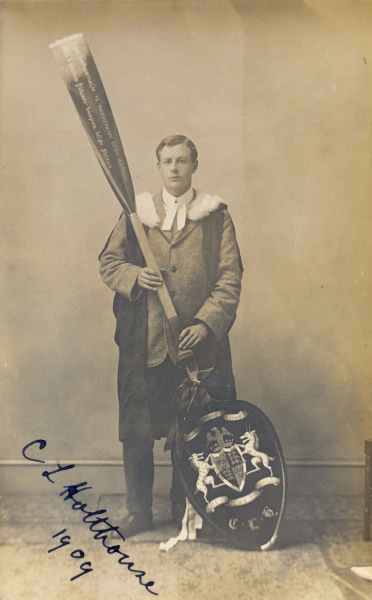Exhilaration and anxiety: The Dos and don’ts of fresher life – Victorian style
Lessons on how to be cool and stay out of trouble for the apprehensive freshers of 1893; student pranks including a paranormal hoax debunked by Sir Isaac Newton and a car suspended from the Bridge of Sighs; and photographs of the proud student who would be the last to receive the wooden spoon – a prize traditionally awarded to the man who scraped through the maths tripos by the skin of his teeth: A new exhibition offers a snapshot of student experience at St John’s College, Cambridge, over half a millennium of teaching.
With the start of the new academic year at Cambridge University fast approaching, many of the young people about to embark on their studies will be unsure about what to expect and how to behave as an undergraduate.
The combination of exhilaration and anxiety felt by any student on their first day away from home is what motivated Arthur John Story, an undergraduate in 1893 at St John’s College, University of Cambridge, to write a conduct manual for new arrivals.
The guide told apprehensive freshers how to be cool, how not to annoy their neighbours and how to avoid getting themselves into trouble. The dogmatic prescriptions offered pearls of wisdom such as: “Don’t, if you are in lodgings, get too familiar with your landlady’s daughter, as she is probably more clever than you” and “Don’t attempt to keep every brand of wine under the sun. Most Undergrads cannot distinguish ‘Bordeaux’ from ‘Burgundy’ if served in a decanter.”
This is just one of many fascinating items going on public display at St John’s as part of Open Cambridge 2016. The elements of student life over 500 years that have changed beyond recognition, and those that have remained exactly the same, can be glimpsed through the exhibition of letters, diaries, photographs and personal items taking place in the Old Library at the College.
The exhibition reveals that while certain aspects of past student experience seem completely alien in the present day – such as a lack of washing facilities and strange social hierarchy – some things – such as homesickness, battling distraction and the thrill of independence– remain a constant feature of university life.
Highlights of the display include the diary of Abraham de la Pryme, who kept a record of his time as an undergraduate at St John’s in the 1690’s. Pryme talks of pranks as an essential part of student life and describes an event where some students tricked the local people of Cambridge into thinking that a house was haunted. After causing mass hysteria, a passer-by was quick to publicly debunk the student’s farcical behaviour, shouting “Fy, Fy! Go home for shame!”. Unfortunately for the students, the ‘passer-by’ happened to be Sir Isaac Newton, widely recognised as one of the most influential scientists of all time.
The exhibition also features newspaper clippings of more modern College escapades; such as when a group of Engineering students keen to prove their creativity, suspended a car from the Bridge of Sighs in 1963. The College maintenance team must have been thrilled when it took six of them two hours to free the car and remove it via punt.

Another highlight of the display are photographs of John’s student Cuthbert Holthouse proudly clutching a giant wooden spoon in 1909. The spoon was a trophy traditionally awarded to the Maths student who came bottom of his class and was a highly sought-after prize until the practice was abolished in the early part of the 20th century.
Holthouse’s spoon was the last to be awarded and many years later, when Holthouse was an old man, it was returned to St John’s and now hangs in the Fellows’ Combination Room in Second Court.
Changing perceptions about how academic merit should be appraised are also reflected in the display, with a shift from medieval traditions of learning such as logic and rhetoric to an interest in the observable world and analytical engagement with a subject.
Many of the brilliant scholars featured in the exhibition, such as the medical pioneer William Heberden (1710-1801), the astronomer John Couch Adams (1819-1892) and the poet Henry Kirk White (1785-1806), came up to the College from low-income families as sizars or through scholarships – schemes that foreshadowed the studentships and other support initiatives that St John’s continues to offer.
Finally, the exhibition explores the beginnings of the diverse community the College is proudly home to today - documenting the arrival of the first international students in the 19th century and the admission of women as fully-fledged members of the College in the 20th.
Student experience at St John’s through the centuries is open on Friday 9 September from 2pm to 4:30pm and on Saturday 10 September from 2pm to 5pm in the Old Library at St John’s College. Entry is free.
Another exhibition, Opening the Great Gate, which profiles a famous student from each of the five centuries of teaching, including the photographer and academy award winner Cecil Beaton, is also open to the public from 9am to 5pm, Monday to Friday.
To view images of some of the items in the exhibition, click here
To find out more about the Old Library and special collections at St John’s College visit: http://www.joh.cam.ac.uk/library